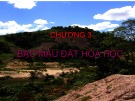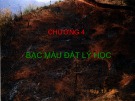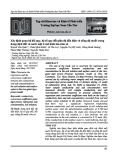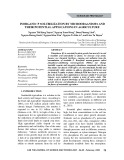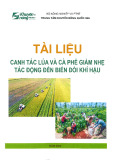
Journal of Science and Transport Technology Vol. 1 No. 1, 1-8
Journal of Science and Transport Technology
Journal homepage: https://jstt.vn/index.php/en
JSTT 2021, 1 (1), 1-8
Published online 09/11/2021
Article info
Type of article:
Original research paper
DOI:
https://doi.org/10.58845/jstt.utt.2
021.en.1.1.1-8
*Corresponding author:
E-mail address:
quantv@utt.edu.vn
Received: 27/09/2021
Revised: 17/10/2021
Accepted: 20/10/2021
Prediction of California Bearing Ratio (CBR)
of Stabilized Expansive Soils with
Agricultural and Industrial Waste Using Light
Gradient Boosting Machine
Van Quan Tran1,*, Hai Quan Do2
1University of Transport Technology, Hanoi 100000, Vietnam
2Center for Structures and Materials, Viettel Aerospace Institute - Viettel Group,
Lot D26, Cau Giay New Urban Area, Yen Hoa ward, Cau Giay District, Hanoi,
Vietnam
Abstract: Using agricultural and industrial waste such as bagasse ash,
groundnut shell ash and coal ash in stabilizing expansive soils are used as a
subgrade material to reduce harmful impaction of swelling/shrinkage of
expansive soils, reduce construction costs. It is also a solution for
environmental protection. California Bearing Ratio (CBR) is an important
criterion to evaluate the application technique of stabilized expansive soil such
as road construction, building construction, highway construction, airport
construction, etc. Using the traditional method such as experimental methods
or empirical approach, the estimation of CBR of stabilized expansive soils is
costly, time consuming for the experiment or low accuracy for empirical
method. In this investigation, open-source code of Machine Learning technique
Light Gradient Boosting Machine algorithm is introduced to predict the CBR. In
order to build model, data of 207 experimental samples was synthesized from
the literature to create a database. The database consists of 6 input variables
(ash content, ash type, liquid limit LL, plastic limit PL, optimum moisture content
OMC and maximum dry density MDD) to obtain output variable CBR. The
results show that the LightGBM model can successfully predict the CBR of
stabilized expansive soils with high accuracy. The ash content is the most
important input factor for CBR prediction using LightGBM model. In order of
importanc input factor affecting CBR prediction are ash content, MDD, ash
type, OMC, LL, PL.
Keywords: Stabilized expansive soil, Machine learning, Light Gradient
Boosting, California Bearing Ratio (CBR), Agricultural/Industrial waste.
1. Introduction
Swelling/Shrinkage of expansive soils
causes mechanical deterioration of the subgrade
where the variation of water content takes place.
Therefore, the strong swelling/shrinkage occurs,
that will induce the instability of subgrade
structures which affects the safety of construction.
Stabilizing expansive soils is the appropriate
technique in limiting the negative effects of
swelling/shrinkage of expansive soils.
Cementitious materials are often selected for the
stabilized soil process to improve the mechanical

JSTT 2021, 1 (1), 1-8
Tran & Do
2
properties of the expansive soils. In addition, using
cementitious materials derived from agricultural
and industrial waste such as bagasse ash,
groundnut shell ash and coal ash contributes both
in environmental protection and sustainable
development.
To evaluate the mechanical properties such
as stiffness modulus and shear strength of
expansive soils after stabilization process of the
subgrade of construction project such as road
foundation, airport foundation, etc., California
Bearing Ratio (CBR) is often used. CBR is an
indirect measurement where the CBR value is the
ratio between the strength value of the subgrade
material and the strength of the standard crushed
rock. In fact, the different soil samples need to be
collected and compacted to determine the Optimal
Moisture Content (OMC) and Maximal Dry Density
(MDD) in experimental measurement of CBR. In
next step, these samples are then further soaked
in water for four days before the CBR
determination are carried out. The process of
determining the CBR index takes about a week.
Therefore, the number of samples to be
determined is high for the large project area that
will require a long time as well as high cost. The
extended time leads to an increase in the project
cost. To overcome this situation, the CBR index can
be estimated from easily identifiable parameters of
soil such as Atterberg limits, effective compaction
process (OMC, MDD). A number of studies have
been conducted to provide empirical equations to
determine CBR. Black [1] introduced an empirical
relation between CBR and plasticity index (PI).
CBR can be empirically estimated from liquid limit
(LL) and PI [2]. More complex, different empirical
correlation equations between CBR and LL, plastic
limit PL, PI and effective compaction were also
established [3], [4]. However, these equations were
given with a small number of experimental
samples, so the general and accuracy of these
equations can be increased.
Machine learning (ML) and Artificial
Intelligence (AI) techniques have been strongly
developed in recent years with advantages such as
high accuracy, fast computation time, saving
design costs. Especially, the ML model has high
generality and accuracy when the model uses
large samples in training the model. Therefore, ML
models have been applied to solve many problems
in civil engineering such as determination of pile
bearing capacity [5], [6], unconfined compressive
strength of stabilized soil [7], compressive strength
of concrete [8], [9], etc. Therefore, the ML models
have been developed in determining the CBR of
stabilized expansive soils. Taskiran [10] developed
the Genetic expression programming (GEP)
algorithm to predict the CBR of stabilized
expansive soil. The CBR value can be also
predicted by Artificial Neural Network (ANN)
models [11]. In the development of actual machine
learning technique, the accuracy of ML models can
be improved. Light Gradient Boosting Machine is a
new machine learning technique developed by
Microsoft corporation [12] which has been
proposed in the present study to determine the
CBR of stabilized expansive soils. Model
performance of the ML model are evaluated by
different criteria such as correlation coefficient R,
root mean square error RMSE and mean absolute
error MAE.
2. Machine learning approach
2.1. Light Gradient Boosting Machine
Light Gradient Boosting Machine (LightGBM)
is an open-source library providing an effective
implementation of gradient boosting framework
based on tree-based learning algorithms [13]. This
algorithm has been designed by Microsoft
Corporation since 2016. The algorithm has some
advantages such as faster speed of training and
high accuracy, reliability with low memory usage to
run. The large-scale data in regression problem
can be efficiency handled by this algorithm.
LightGBM is a relatively new algorithm and easily
performed using Python library and list of
parameters given in the LightGBM documentation
[12].
2.2. Performance evaluation of machine

JSTT 2021, 1 (1), 1-8
Tran & Do
3
learning model
In this process, three performance criteria
were used namely correlation coefficients R, root
mean square error RMSE and mean absolute error
MAE to assess the accuracy of LighGBM model
[7]:
( )( )
( ) ( )
N
0,j 0 t,j t
j1
NN
22
0,j 0 t,j t
j 1 j 1
p p p p
R
p p p p
=
==
−−
=
−−
(1)
( )
N2
0,j t,j
j1
1
RMSE p p
N=
=−
(2)
( )
N
0,j t,j
j=1
1
MAE= p -p
N
(3)
Where: N is the number of data sets, p0 and
0
p
is the experimental value and average
experimental value, pt and
0
p
is predicted value
and average predicted value using LightGBM. R
measures the predicted and experimental value
association, if the R is closer to 1, the LightGBM
model is more accurate. RMSE calculates the
square root average difference between the
expected values and the experimental values and
the difference between the experimental and the
predicted values is determined MAE criteria.
RMSE and MAE value are closer to 0, the
accuracy of the LightGBM is higher.
3. Construction and analysis of database
In this study, the database is built based on
the data collection from Rajakumar and Reddy [11],
in which 207 experimental samples of stabilized
expansive soils are designed with different types of
ash (coal ash-type 1, bagasse ash-type 2 and
groundnut shell ash-type 3), ash content, Atterberg
limits (LL and PL), effective compaction (OMC and
MDD). Therefore, LightGBM algorithm uses 6 input
variables consisting of: (1) ash type (labelled 1, 2
and 3); (2) ash content (%); (3) LL (%); (4) PL (%),
(5) OMC (%) and (6) MDD (g/cm3). CBR (%) is
considered only output variable. The whole dataset
was randomly divided into two sub-datasets
including 70% of whole samples for training
LightGBM model corresponding to 145 samples.
The remaining samples consisting of 30% of the
whole data corresponds to the 62 samples used for
testing model. The statistical analysis of database
is presented in Table 1.
As mentioned in the above section, three ash
types of agricultural waste consisting of coal ash
labelled 1, bagasse ash labelled 2 and groundnut
shell ash labelled 3 are used for stabilizing
expansive soil. With the data distribution shown in
Fig 1, the number of samples using coal ash is
slightly used more than that using the other ash.
The used ash content varies from 0% to 60% by
(mean value of 14.03 % and median value of
8.00%). The LL and PL range from 17% to 64%
(mean value 39.383% and median value 39.000%)
and 12.8 to 30.1% (mean value 20.646% and
median value 20.000%), respectively. The OMC
and MDD vary from 8.91% to 32.5% (mean value
17.775% and median value 17.020%) and 1.37
g/cm3 to 1.88 g/cm3 (mean value 1.615 g/cm3 and
median value 1.620 g/cm3). Moreover, the data
distribution shown in Fig 1 indicates that each input
variable seems to weakly correlate with output
CBR. Especially, Ash type, PL and OMC seem to
not correlate with CBR.
Table 1. Statistical analysis of database
Count
Mean
Std
Min
Q25%
Q50%
Q75%
Max
Skw
Ash type
207
1.986
0.815
1.000
1.000
2.000
3.000
3.000
0.027
Ash content (%)
207
14.029
16.650
0.000
4.000
8.000
12.000
60.000
1.593
LL (%)
207
39.383
10.533
17.000
32.200
39.000
46.750
64.000
0.215
PL (%)
207
20.646
4.565
12.800
16.900
20.000
24.050
30.100
0.341
OMC (%)
207
17.775
5.107
8.910
13.915
17.020
21.200
32.500
0.508
MDD (g/cm3)
207
1.615
0.103
1.370
1.535
1.620
1.680
1.880
0.308
CBR (%)
207
3.775
0.990
1.860
3.055
3.890
4.510
6.460
-0.149
Skw=Skewness; Std=Standard deviation

JSTT 2021, 1 (1), 1-8
Tran & Do
4
(a)
(b)
(c)
(d)
(e)
(f)
Fig 1. Distribution and correlation line of each input variable and CBR output
Fig 2. Correlation matrix of input and output variables

JSTT 2021, 1 (1), 1-8
Tran & Do
5
In fact, the correlation matrix of input and
output variables (Fig 2) shows the ash type, PL and
OMC have weak correlation coefficients to e equal
to 0.1 and 0, respectively. The correlation between
inputs and output, the highest correlation
coefficient belongs to LL and CBR, the correlation
coefficient is equal to -0.5, it means that higher LL,
the CBR decrease. Correlation between 6 input
variables, the highest correlation is OMC and PL
with the coefficient to be equal to 0.8. However, all
correlation coefficients are not high enough to
reduce the proposed number of inputs. Moreover,
the six input variables can be useful for the feature
importance in last section of the paper.
4. Results and discussion
In this study, LightGBM algorithm is
performed using the Python programming
language. Using the default hyperparameter
implemented in Python, the typical prediction
results of the LightGBM are assessed in Fig 3 for
graphical demonstration. The experimental and
predicted CBR of stabilized expansive soils are
compared in Fig 3 consisting of the training dataset
(Fig 3a) and the testing dataset (Fig 3b). The
results show that the predicted CBR of the both
training and testing part is in excellent coherent
with experimental values. Excellent agreement
between experimental and predicted CBR is also
indicated by histograms of error prediction for the
training dataset (Fig 4a) and testing datasets (Fig
4b). It can be observed that the prediction errors of
the training and testing datasets are relatively
small. Error values ranges from -0.5 to 0.5%. The
error cumulative lines also indicate that about 145
prediction error values vary from -0.5 to 0.5% and
5 prediction values are out of this range for the
training part. In testing part, only 6 prediction error
values are out of range -0.5 to 0.5%. These error
results confirm that the predictive performance of
the LightGBM model is excellent algorithm to
predict the values of CBR of stabilized expansive
soils with agricultural waste including coal ash,
bagasse ash, and groundnut shell ash.
The regression graphs of both the training
part and testing part are presented in Fig 5. It is
worth noting that the predictive capability of
LightGBM model is high. The performance values
are R=0.9473, RMSE=0.3303, MAE=0.2530 and
R=0.9385, RMSE=0.3037, MAE=0.2506 for the
training and testing parts, respectively. Using
MATLAB software, the performance values of ANN
model in Rajakumar et Babu [11] are expressed by
the correlation coefficient R and the mean square
error MSE with the best performance values
R=0.9432 and MSE=0.49 (RMSE=0.7000) for the
whole dataset. These performances values are
lower than that of this investigation consisting of
R=0.9452 and RMSE=0.3225 for all dataset (Fig
5c). Moreover, LightGBM is open source of Python
programming langue so that this algorithm can be
easily approached both by the engineers and
researchers.
Therefore, using LightGBM model to predict
the CBR of stabilized expansive soils is feasible
with high accuracy and user friendly. It could be
suited for developing a numerical tool for
determining the CBR of stabilized expansive soils
for geotechnical engineer.
Fig 6 shows the feature importance analysis
of CBR prediction of stabilized expansive soil. The
most importance input is the ash content used for
stabilizing expansive soil. The first feature ash
content is more important 20 times than the second
feature MDD (feature importance value 1.5 versus
0.25). The lowest important input is the plastic limit
which has the feature importance value to be quite
equal to 0. Therefore, this feature can be not taken
account for training LightGBM model in predicting
CBR of stabilized expansive soils in the future. The
liquid limit influence on CBR lower than OMC. Ash
type has greater importance than OMC. Overall,
the mix design containing ash content and ash type
have strong importance on the CBR prediction, the
effective compaction (OMC and MDD) influence
more importantly than Atterberg limits in predicting
the CBR of stabilized expansive soils.





